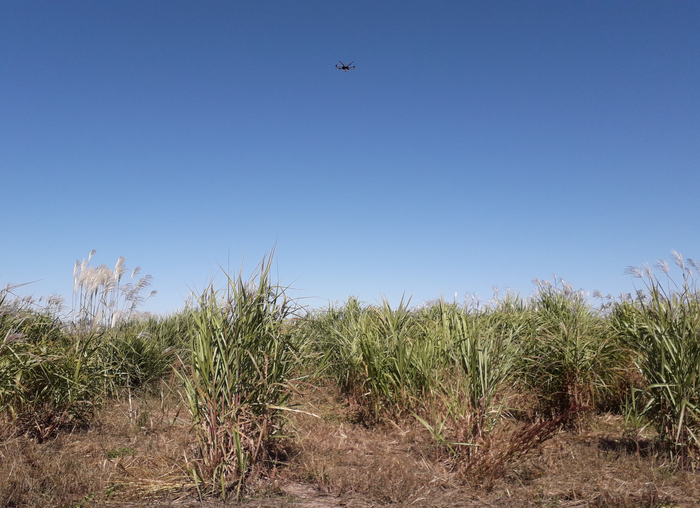Miscanthus is one of the most promising perennial crops for bioenergy production since it is able to produce high yields with a small environmental footprint. This versatile grass has great potential to perform even better, as much less effort has been put into improving it through breeding relative to established commodity crops such as maize or soybean.

Credit: Center for Advanced Bioenergy and Biofuels Innovation (CABBI)
Miscanthus is one of the most promising perennial crops for bioenergy production since it is able to produce high yields with a small environmental footprint. This versatile grass has great potential to perform even better, as much less effort has been put into improving it through breeding relative to established commodity crops such as maize or soybean.
However, breeding must become faster and more efficient if it is to reach the potential for sustainable and resilient biomass production in miscanthus. A key bottleneck in the process is the ability to measure the growth of thousands of varieties of the crop in the field and select the small number of varieties that perform best. This requires new, sophisticated technologies for capturing data and analyzing it.
A study by researchers at the Center for Advanced Bioenergy and Bioproducts Innovation (CABBI) demonstrated how unmanned aerial vehicles (UAVs, or drones) combined with cutting-edge machine learning methods can assist the selection of the best candidate genotypes in miscanthus breeding programs. The team used neural nets — computer systems modeled on the human brain and nervous system — to analyze very high-resolution aerial imagery and identify key miscanthus traits during the crop’s growing season.
In particular, the CABBI researchers highlighted that using neural networks that are designed to analyze data in three-dimensions (two dimensions in space, plus time) allowed better estimates of crop traits (flowering time, height, and biomass production) than traditional neural networks that analyze data in only two dimensions in space. This allowed them to leverage information on how each of the thousands of plants in the field change over time. In addition, the three-dimensional neural network proved able to automatically perform aspects of the image analysis process (i.e., finding plants in the image) which in many other cases requires substantial manual intervention that would slow the process down.
This is especially important in highly productive perennial grasses such as miscanthus, where in-field phenotyping is more challenging as well as more rewarding.
The study, published in Remote Sensing, was led by Postdoctoral Researcher Sebastian Varela at CABBI, a U.S. Department of Energy-funded Bioenergy Research Center; Andrew Leakey, CABBI Director, Professor and Head of the Department of Plant Biology, and Professor at the Carl R. Woese Institute for Genomic Biology (IGB), Department of Crop Sciences, and the Center for Digital Agriculture at the University of Illinois Urbana-Champaign; and Erik Sacks, CABBI’s Deputy Theme Leader for Feedstock Production and Professor of Crop Sciences and IGB at Illinois.
It was the first attempt to use data-intensive monitoring of large, genetically diverse populations of miscanthus using digital technologies. For their assessment, researchers used drones to capture high-resolution images of crops 10 times during the growing season, together with ground-based data for thousands of miscanthus genotypes, to determine their flowering time, height, and biomass yield. The imaging combined photogrammetry, which provides digital surface models, and multispectral sensing technology that can obtain images not visible to the human eye.
“This is an exciting step toward developing digital applications that can ease the selection of the best candidate genotypes for a fraction of the cost of traditional manual screening,” Leakey said. “That is just one key step in the broader work CABBI is doing to deliver the scientific understanding and technological advances needed to make environmentally beneficial and profitable bioenergy a reality for the Central U.S.”
Said Sacks: “Our standard methods for measuring miscanthus traits, like yield and height, take a long time and a lot of labor, but these new imaging methods are faster and much less expensive. With the newer methods, we can evaluate larger populations of miscanthus for the same money — and that will enable us to select better breeding lines and cultivars more quickly.”
Co-authors on the study included Ph.D. student Xuying Zheng, undergraduate Dylan P. Allen, and research technician Jeremy Ruhter, all with CABBI and Crop Sciences; and Ph.D. student Joyce N. Njuguna of Crop Sciences.
Read the full paper here: https://www.mdpi.com/2072-4292/14/21/5333/htm
Journal
Remote Sensing
DOI
10.3390/rs14215333
Method of Research
Experimental study
Subject of Research
Not applicable
Article Title
Deep Convolutional Neural Networks Exploit High-Spatial- and -Temporal-Resolution Aerial Imagery to Phenotype Key Traits in Miscanthus
Article Publication Date
25-Oct-2022




